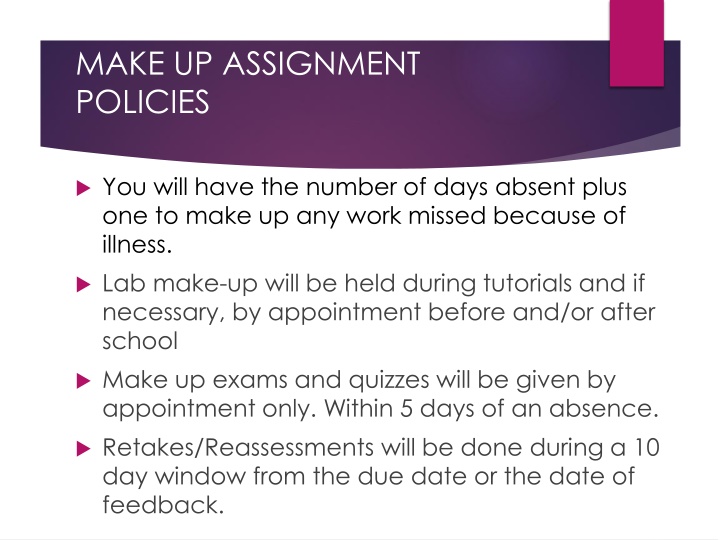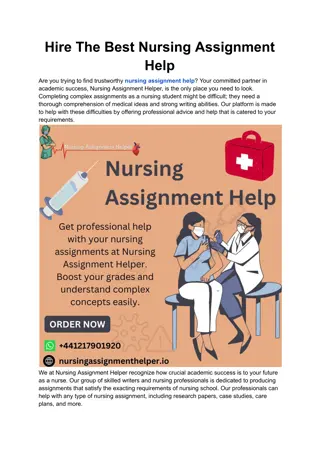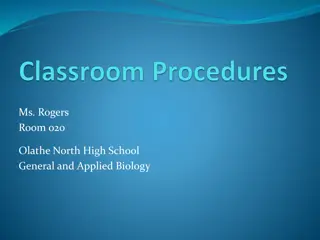Assignment Policies and Classroom Procedures for Success
Efficient makeup assignment policies are implemented to assist students in keeping up with missed work due to illness or extracurricular activities. Late work policies, homework expectations, daily quizzes, and classroom participation guidelines are outlined to ensure academic integrity and student success. Additionally, detailed information on the cardiovascular system is provided in the curriculum.
Download Presentation

Please find below an Image/Link to download the presentation.
The content on the website is provided AS IS for your information and personal use only. It may not be sold, licensed, or shared on other websites without obtaining consent from the author.If you encounter any issues during the download, it is possible that the publisher has removed the file from their server.
You are allowed to download the files provided on this website for personal or commercial use, subject to the condition that they are used lawfully. All files are the property of their respective owners.
The content on the website is provided AS IS for your information and personal use only. It may not be sold, licensed, or shared on other websites without obtaining consent from the author.
E N D
Presentation Transcript
MAKE UP ASSIGNMENT POLICIES You will have the number of days absent plus one to make up any work missed because of illness. Lab make-up will be held during tutorials and if necessary, by appointment before and/or after school Make up exams and quizzes will be given by appointment only. Within 5 days of an absence. Retakes/Reassessments will be done during a 10 day window from the due date or the date of feedback.
MAKE UP ASSIGNMENT POLICIES If the assigned work was due on the day you were absent, I expect it the day you return. Any major work that was assigned prior to the absence is due on the due date. If you miss class because of band, football, choir, basketball, baseball, golf, tennis, volleyball, theatre arts, orchestra, or any other extracurricular activity, you must turn in your work before you leave. If you miss class because of band, football, choir, basketball, baseball, golf, tennis, volleyball, theatre arts, orchestra, or any other extracurricular activity, you must turn in your work before you leave
LATE WORK & HOMEWORK AND DAILY QUIZZES Turning in assignments in a timely manner is important for student success. All assignments are expected on the day they are due. Homework will be assigned and graded at the teacher s discretion. However, there will be a quiz the first 10-20 minutes the following class period. Expect a quiz everyday covering the material from previous class
Classroom procedures and policies Class participation is instrumental for success. Plan to be active in class discussions. Copying, borrowing, looking at another student s test, quiz or homework assignment is cheating. Cheating will be handled according to the district s academic integrity policy and will be strictly enforced. Tardies to class will be handled according to school policy. All district guidelines found in the Student Code of Conduct will be observed. o 1st Tardy = warning, 2nd Tardy = 30 min teacher detention, 3rd Tardy = 30 min teacher detention and parent notification, 4th Tardy = principal referral
11 The Cardiovascular System Lesson 1: Heart Anatomy and the Function of the Cardiovascular System Lesson 2: Regulation of the Heart Lesson 3: Blood Vessels and Circulation Lesson 4: Heart Disease
Chapter 11: The Cardiovascular System Lesson 1 Heart Anatomy and the Function of the Cardiovascular System
Anatomy and the Function of the Cardiovascular System the heart: location and size the four chambers of the heart the heart valves blood flow through the heart walls of the heart cardiac cycle cardiac output
The Heart: Location and Size thoracic cavity above diaphragm between lungs size of a clenched fist weighs 8 12 ounces
The Four Chambers of the Heart right atrium right ventricle left atrium left ventricle
The Heart Valves atrioventricular (AV) valves tricuspid bicuspid (mitral) semilunar valves pulmonary aortic
Review and Assessment Match these words with 1 4 below: tricuspid, thoracic cavity, ventricle, aortic. 1. atrioventricular valve 2. semilunar valve 3. location of heart 4. heart chamber
Welcome to class video
OBJECTIVES I will be able to describe the function of the cardiovascular system. I will be able to describe the location, size, and structures of the heart. I will be able to trace the path of blood through the heart.
Youve been Frizzled! Attention Red Blood cells (I m talking about YOU!) Surprise for today you are doing a walkthrough of the heart We re going to walk to the lab and we want each student to sit at their numbered spot with their partners At each lab station will be an index card with a name of a part of the heart, a tidbit of information.
Quick Preview video
Each station is labeled You will have about 2 minutes per station follow the instructions at each station making sure that you fill out your worksheet and label your heart on the back of your worksheet. Don t worry if you don t get all of the clues we will go over all of this when we get back to the classroom. You will have a ball that is red or ball that is blue (depending on if the blood is oxygenated or deoxygenated)
A quick heart to heart Click here
Blood Flow through the Heart (1) deoxygenated blood flows from the body to the inferior and superior vena cavae to right atrium (2) right atrium contracts, forcing blood through the tricuspid valve to right ventricle (3) right ventricle contracts, forcing blood through the pulmonary valve, to the pulmonary artery (4) blood exits to the lungs
Blood Flow through the Heart (continued) (5) oxygenated blood from lungs travels through the pulmonary veins to the left atrium (6) left atrium contracts, forcing blood through the mitral valve to the left ventricle (7) left ventricle contracts, forcing blood through the aortic valve (8) blood passes to the aorta (9) blood travels out to parts of the body
Walls of the Heart epicardium outermost layer myocardium middle layer endocardium inner layer
Cardiac Cycle diastole ventricle relax, atria contract systole ventricles contract, atria relax mean arterial pressure overall pressure within cardiovascular system
Cardiac Output amount of blood pumped by heart in 1 minute measured in liters/minute stroke volume amount of blood pumped in 1 beat heart rate number of beats per minute
Review and Assessment True or False? 1. The ventricles contract in diastole. 2. Stroke volume is measured in beats/minute. 3. The epicardium is the inner heart layer. 4. Deoxygenated blood enters the left atrium. 5. The aortic valve is in the left ventricle.
Chapter 11: The Cardiovascular System Lesson 2 Regulation of the Heart
Regulation of the Heart internal control of the heart external control the conduction system
Internal Control of the Heart sinoatrial node pacemaker sends electrical impulse tells heart to beat 60 100 bpm
External Control of the Heart the cardiac center sympathetic nerve system speeds up parasympathetic nerve system slows down the endocrine system some hormones speed up
The Conduction System SA node AV node bundle of His bundle branches right and left Purkinje fibers
Electrocardiogram ECG or EKG electrical activity of the heart depolarize contract repolarize relax
Cardiac Arrhythmias normal contractility condition sinus rhythm abnormal contractility condition arrhythmia ventricle or atria contraction is not normal
Cardiac Arrhythmias bradycardia slow heart beat tachycardia fast heart beat premature atrial contraction (PACs) atria contracts before SA node
Cardiac Arrhythmias atrial fibrillation atria contract faster than 350 bpm premature ventricular contractions (PVCs) ventricles contract too soon ventricular tachycardia (VT) ventricles, rather than SA node, cause beat
Cardiac Arrhythmias ventricular fibrillation (VF) ventricles contract faster than 350 bpm heart block impulse from SA node to AV node first impulse delayed second intermittently blocked third completely blocked
Defibrillators and Life- Threatening Arrhythmias automatic external defibrillator (AED) electric shock stops heart allows heart to start normal rhythm anyone can use one
Review and Assessment Match these words with 1 4 below: parasympathetic, EKG, SA node, sympathetic. 1. speed up 2. slow down 3. pacemaker 4. electrical activity of the heart
Review and Assessment Fill in the blanks with: Tachycardia, Atrial fibrillation, Bradycardia, or Defibrillator. 1. _______________ is fast heart beat. 2. _______________ is slow heart beat. 3. _______________ is atria beating more than 350 bpm. 4. A(n) _______________ stops the heart so it can reset.
11.2 quiz Fill in the blanks with: Tachycardia, Atrial fibrillation, Bradycardia, Defibrillator. Parasympathetic, EKG, SA node, or sympathetic, 1. If a lion walks in the room this and it causes your heart to speed up this is a ____________ response 2. pacemaker of the heart is the _____________ 3. ______________ is fast heart beat. 4. ______________ is slow heart beat.
Chapter 11: The Cardiovascular System Lesson 3 Blood Vessels and Circulation
Blood Vessels and Circulation blood vessels: the transport network circulation: moving blood around the body taking vital signs know your numbers
Blood Vessels: The Transport Network structure and function of vessels
The Three Layers of Blood Vessels tunica intima innermost layer tunica media middle layer tunica externa outermost layer
Differences between Arteries and Veins
Capillaries exchange vessels gas moves between tissue and blood capillary bed network of exchange vessels precapillary sphincters close off capillary bed as needed
Circulation: Moving Blood around the Body cardiopulmonary circulation between heart and lungs systemic circulation between heart and body
Circulation: Moving Blood around the Body
Review and Assessment True or False? 1. Systemic circulation moves blood to lungs. 2. Capillaries are exchange vessels. 3. The tunica intima is the innermost layer. 4. Arteries move blood away from the heart. 5. Veins move blood toward the heart.
Cardiac Circulation coronary arteries left right coronary sinus
Hepatic Portal Circulation maintains proper levels in the blood carbohydrate fat protein























